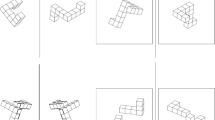Abstract
The goal of the experiment reported was to replicate the previous Sarrazin’s (2000) study in order to verify, with an adequate methodological procedure, whether or not the closure principle applied in spatial and temporal reproduction tasks. The hypothesis defended was that the closure of the pattern is an intrinsic property of the structuring process in spatial memory. The stimuli consisted of eight visually presented dots that appeared sequentially with inter-dot distances corresponding to inter-dot durations. After a learning phase, participants reproduced the spatial (space condition) or temporal (time condition) characteristics of the target 60 times in succession. We analyzed the variance level for both element location and Inter-Element-Interval (IEI) on spatial and temporal responses. Two main results emerge from this experiment: (1) the critical dependency of the closure principle to the nature (spatial or temporal) of the response, (2) the importance to consider both locations and intervals as complementary information. These results are discussed in the light of physical system, in particular in term of compensation phenomenon and we proposed a mathematical model that replicates the qualitative feature of variance for both space and time conditions.






Similar content being viewed by others
References
Anderson NH (1974) Algebric models in perception. In: Carterette EC, Friedman MP (Eds) Handbook of perception, vol 2. Academic Press, New York
Bartlett FC (1932) Remembering: a study in experimental and social psychology. Cambridge: Cambridge University Press
Berberian B (2003) Dynamique visuo-spatiale du souvenir: étude de la structuration de l’image en mémoire. Master in Human Movement Sciences. University of the Mediterranee
Braun J (1999) On the detection of salient contours. Spat Vis 12(2):211–225
Burnham WH (1903) Retroactive amnesia: illustrative cases and a tentative explanation. Am J Psychol 14:382–396
Carpenter GA, Grossberg S (2003) Adaptive resonance theory. In: Arbib MA (Ed) The handbook of brain theory and neural networks, 2 edn. MIT Press, Cambridge, MA, pp 87–90
Collins JJ, De Luca CJ (1993) Open-loop and closed-loop control of posture: a random-walk analysis of center-of-pressure trajectories. Exp Brain Res 95(2):308–318
Collyer CE (1977) Discrimination of spatial and temporal intervals defined by three light flashes: effects of spacing on temporal judgements. Percept Psychophys 21:357–364
DeCamp JE (1915) A study of retroactive inhibition. Psychol Monogr 19(4), whole no 84
Elder J, Zucker S (1993) The effect of contour closure on the rapid discrimination of two-dimensional shapes. Vision Res 33(7):981–991
Finke RA, Shepard RN (1986) Visual functions of mental imagery. John Wiley, New York
Gibson JJ (1929) The reproduction of visually perceived forms. J Exp Psychol 12(1):1–39
Gibson JJ (1966) The problem of temporal order in stimulation and perception. J Exp Psychol 62:141–149
Giraudo MD, Pailhous J (1999) Dynamic instability of visuospatial images. J Exp Psychol: Hum Percept Perform 25(6):1495–1516
Grossberg S (1987) Competitive learning: from interactive activation to adaptive resonance. Cognit Sci 11:23–63
Grossberg S, Mingolla E (1985) Neural dynamics of perceptual grouping: textures, boundaries, and emergent segmentations. Percept Psychophys 38:141–171
Hebb DO (1949) Organization of behavior: a neuropsychological theory. Wiley, New York
Jones B, Huang YL (1982) Space–time dependencies in psychological judgment of extent and duration: algebric model of the Tau and Kappa effects. Psychol Bull 91:128–142
Koffka K (1935) Principles of Gestalt psychology. Harcourt, Brace and World, New York
Köhler W (1947) Gestalt psychology. Liveright, New York
Koshman S (2006) Visualization-based information retrieval on the web. Libr Inf Sci Res 28(2):192–207
Kovacs I, Julesz B (1993) A closed curve is much more than an incomplete one: effect of closure in figure-ground segmentation. Proc Nat Acad Sci 90(16):7495–7497
Lashley KS (1950) In search of the engram. Cambridge University Press, Cambridge
Loeb J (1901/1973) Comparative physiology of the brain and comparative psychology. Arno Press, New York
Luchins AS, Luchins EH (1959) Rigidity of behavior - a variational approach to the effect of Einstellung. University of Oregon Books, Eugene, Oregon
Newell KM, Corcos DM (1993) Issues in variability and motor control. In: KM Newell, DM Corcos (Eds) Variability and motor control. Human Kinetics Publishers. Champaign IL, pp 1–12
Pettet MW, McKee SP, Grzywacz NM (1998) Constraints on long range interactions mediating contour detection. Vision Res 38(6):865–879
Sarrazin JC (2000) Exactitude et variabilité de patrons spatio-temporels. Master in Human Movement Sciences. University of the Mediterranee
Sarrazin JC, Giraudo MD, Pailhous J, Bootsma RJ (2004) Dynamics of balancing space and time in memory: tau and kappa effects revisited. J Exp Psychol: Hum Percept Perform 30(3):411–430
Schöner G, Kelso JA (1988) Dynamic pattern generation in behavioral and neural systems. Science 239(4847):1513–1520
Tiernan JJ (1938) The Principle of Closure in Terms of Recall and Recognition. Am J Psychol 51(1):97–108
Tversky T, Geisler WS, Perry JS (2004) Contour grouping: closure effects are explained by good continuation and proximity. Vision Res 44(24):2769–2777
Van Geert P (1998) A dynamic systems model of basic developmental mechanisms: Piaget, Vygotsky, and beyond. Psychol Rev 105(4):634–677
Van Wieringen PCW, Beek PJ (1997) Distance versus position information in the control of aiming movements. Behav Brain Sci 20:323–324
Webber CL Jr, Zbilut JP (1994) Dynamical assessment of physiological systems and states using recurrence plot strategies. J Appl Physiol 76(2):965–973
Wertheimer M (1923) Untersuchungen zur Lehre der Gestalt, II. Psychologische Forschung
Acknowledgement
This research was supported by a grant from ACI CNRS “Systèmes Complexes en SHS”.
Author information
Authors and Affiliations
Corresponding author
Rights and permissions
About this article
Cite this article
Sarrazin, JC., Tonnelier, A., Berberian, B. et al. Structuring process and closure principle in spatial and temporal reproduction tasks. Cogn Neurodyn 2, 273–282 (2008). https://doi.org/10.1007/s11571-008-9039-z
Received:
Accepted:
Published:
Issue Date:
DOI: https://doi.org/10.1007/s11571-008-9039-z




